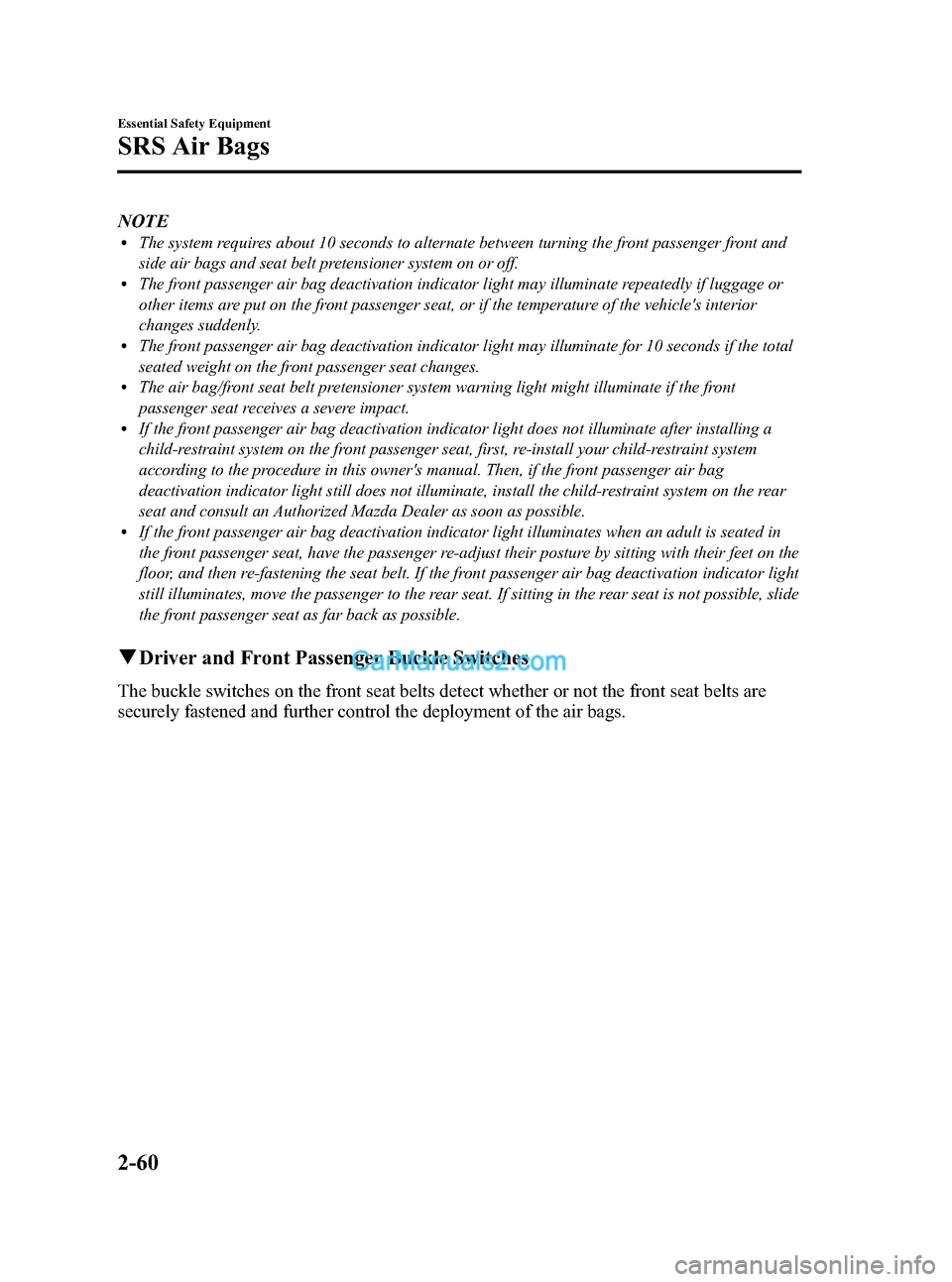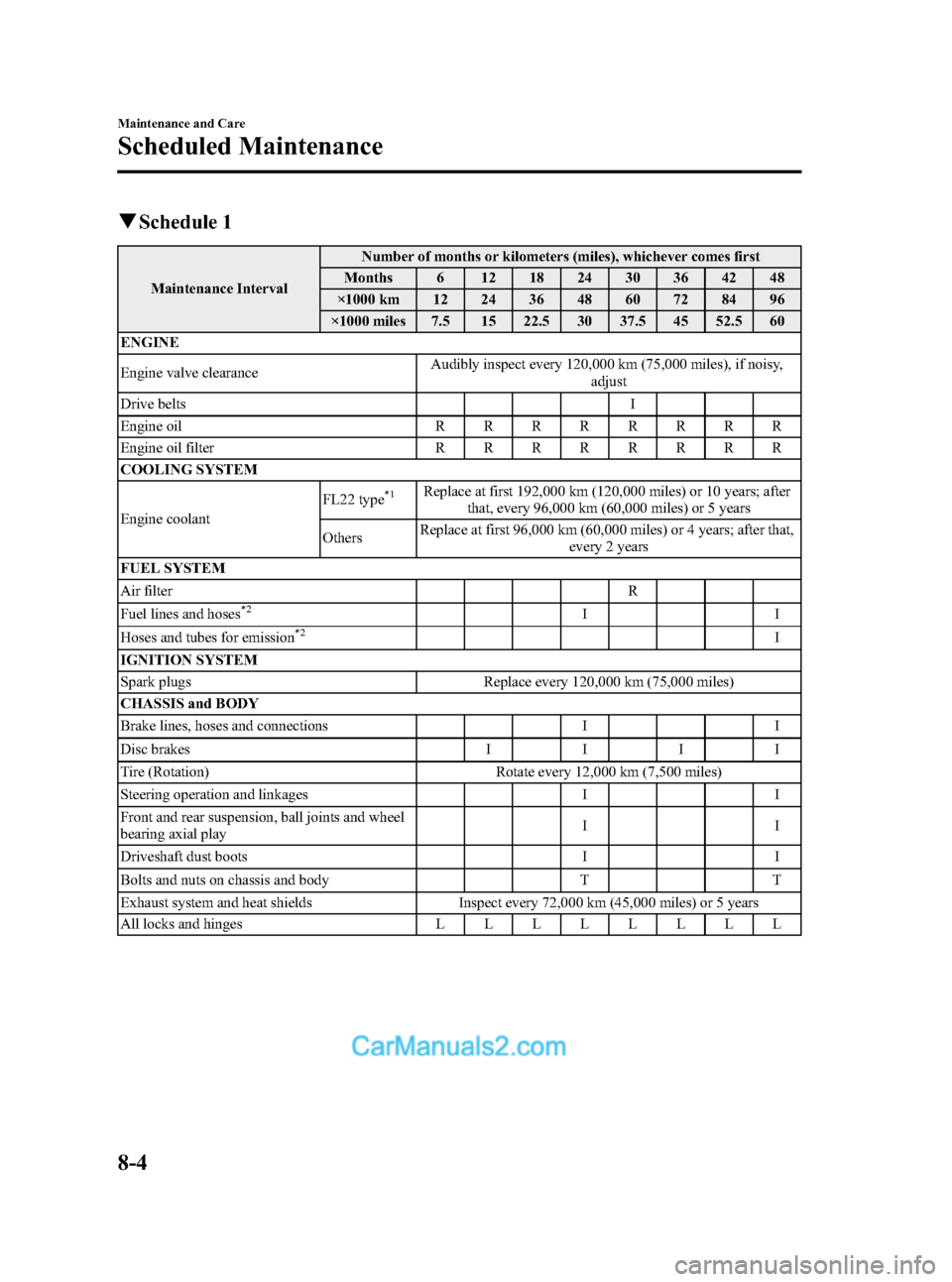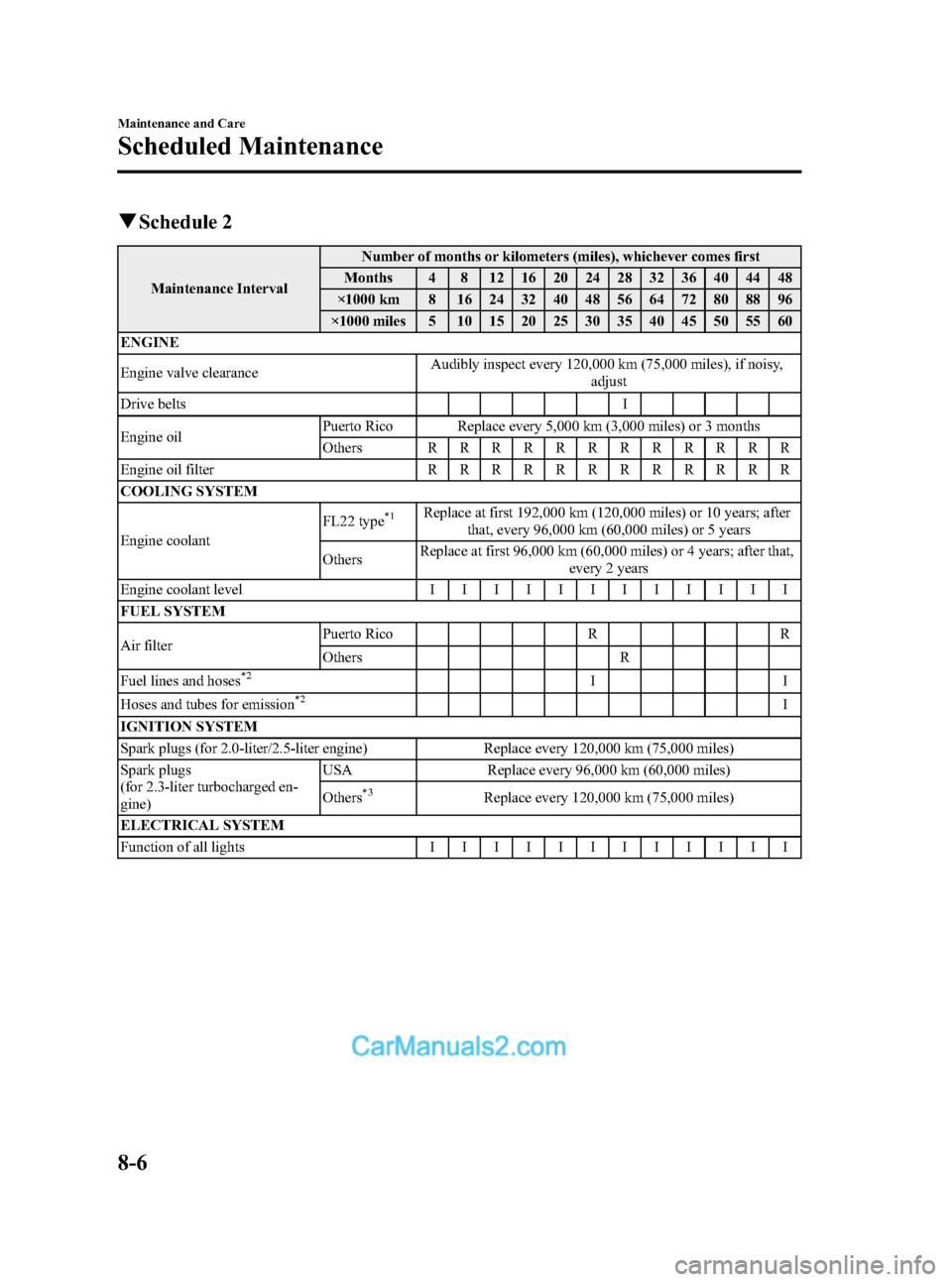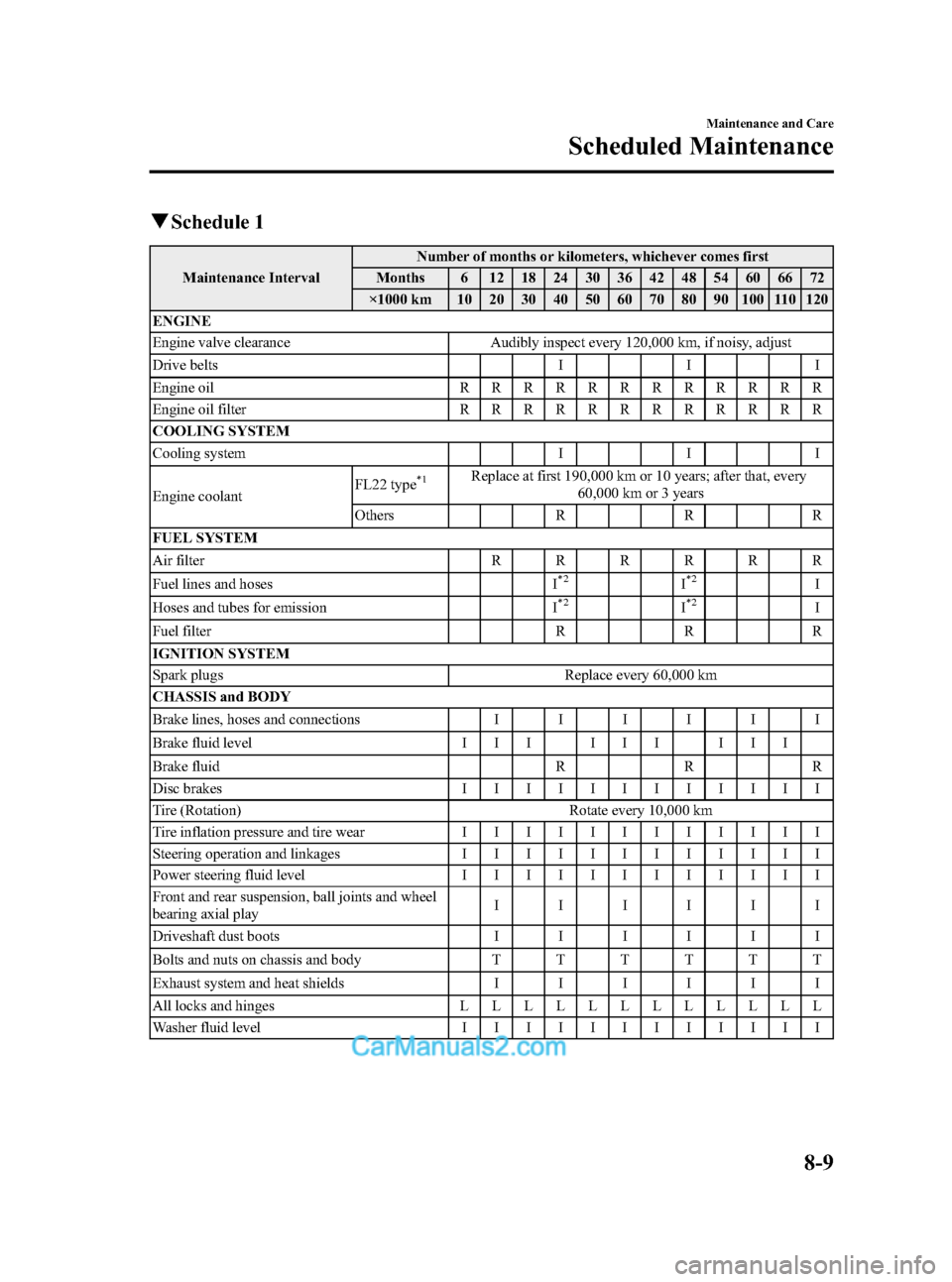drive belts MAZDA MODEL MAZDASPEED 3 2012 (in English) User Guide
[x] Cancel search | Manufacturer: MAZDA, Model Year: 2012, Model line: MODEL MAZDASPEED 3, Model: MAZDA MODEL MAZDASPEED 3 2012Pages: 508, PDF Size: 9.01 MB
Page 59 of 508

Black plate (59,1)
Never use a rear-facing child-restraint system in the front seat with an air bag that
could deploy:
Rear-facing child-restraint systems on the front seat are particularly dangerous even
though you may feel assured that a front passenger air bag will not deploy based on
the fact that the front passenger air bag deactivation indicator light illuminates. The
child-restraint system can be hit by a deploying air bag and moved violently
backward resulting in serious injury or death to the child.
Do not sit too close to the driver and front passenger air bags:
Sitting too close to the driver and front passenger air bag modules or placing hands
or feet on them is extremely dangerous. The driver and front passenger air bags
inflate with great force and speed. Serious injuries could occur if someone is too
close. The driver should always hold onto only the rim of the steering wheel. The
front seat passenger should keep both feet on the floor. Front seat occupants should
adjust their seats as far back as possible and always sit upright against the
seatbacks with seat belts worn properly.
Sit in the center of the seat and wear seat belts properly:
Sitting too close to the side air bag modules or placing hands on them, or sleeping
up against the door or hanging out the windows is extremely dangerous. The side
and curtain air bags inflate with great force and speed directly expanding along the
door on the side the car is hit. Serious injury could occur if someone is sitting too
close to the door or leaning against a window, or if rear seat occupants grab the
sides of the front seatbacks. Give the side and curtain air bags room to work by
sitting in the center of the seat while the vehicle is moving with seat belts worn
properly.
Do not attach objects on or around the area where driver and front passenger air
bags deploy:
Attaching an object to the driver and front passenger air bag modules or placing
something in front of them is dangerous. In an accident, an object could interfere
with air bag inflation and injure the occupants.
Essential Safety Equipment
SRS Air Bags
2-45
Mazda3_8BM5-EA-10F_Edition2 Page59
Monday, July 26 2010 1:52 PM
Form No.8BM5-EA-10F
Page 63 of 508

Black plate (63,1)
How the SRS Air Bags Work
Your Mazda is equipped with the following types of SRS air bags. SRS air bags are
designed to work together with the seat belts to help to reduce injuries during an accident.
The SRS air bags are designed to provide further protection for passengers in addition to
the seat belt functions. Be sure to wear seat belts properly.
qFront Seat Belt Pretensioners
The front seat belt pretensioners are designed to deploy in moderate or severe frontal, near
frontal collisions.
qDriver Air Bag
The driver's air bag is mounted in the steering wheel.
When air bag crash sensors detect a frontal impact of greater than moderate force, the
driver's air bag inflates quickly helping to reduce injury mainly to the driver's head or chest
caused by directly hitting the steering wheel.
For more details about air bag deployment, refer to“SRS Air Bag Deployment Criteria”
(page 2-53).
(With Driver and Front Passenger Occupant Classification System)
The driver's dual-stage air bag controls air bag inflation in two energy stages. During an
impact of moderate severity the driver's air bag deploys with lesser energy, whereas during
more severe impacts, it deploys with more energy.
qFront Passenger Air Bag
The front passenger air bag is mounted in the front passenger dashboard. The inflation
mechanism for the front passenger air bag is the same as the driver's air bag, as mentioned
above.
For more details about air bag deployment, refer to“SRS Air Bag Deployment Criteria”
(page 2-53).
Essential Safety Equipment
SRS Air Bags
2-49
Mazda3_8BM5-EA-10F_Edition2 Page63
Monday, July 26 2010 1:52 PM
Form No.8BM5-EA-10F
Page 73 of 508

Black plate (73,1)
Do not increase the total seated weight on the front passenger seat:
When an infant or small child sits on the front passenger seat, increasing the total
seated weight on the front passenger seat is dangerous. The front passenger seat
weight sensors will detect the increased total seated weight, which could result in the
unexpected deployment of the front passenger front and side air bags and seat belt
pretensioner system in an accident and may cause serious injury. Increasing the total
seated weight on the front passenger seat could result in the front passenger front
and side air bags and seat belt pretensioner system deployment in an accident under
the following conditions, for example:
ØLuggage or other items are placed on the seat with the child in the child-restraint
system.
ØA rear passenger or luggage push or pull down on the front passenger seatback.
ØA rear passenger steps on the front passenger seat rails with their feet.
ØLuggage or other items are placed on the seatback or hung on the head restraint.
ØHeavy items are placed in the seatback map pocket.
ØThe seat is washed.
ØLiquids are spilled on the seat.
ØThe front passenger seat is moved backward, pushing into luggage or other items
placed behind it.
ØThe front passenger seatback contacts the rear seat.
ØLuggage or other items are placed between the front passenger seat and driver
seat.
ØAny accessories which might increase the total seated weight on the front
passenger seat are attached to the front passenger seat.
The front passenger front and side air bags and seat belt pretensioner systems will
deactivate if the front passenger air bag deactivation indicator light illuminates.
CAUTION
ØTo assure proper deployment of the front air bag and to prevent damage to the
sensors in the front seat bottoms:
ØDo not place sharp objects on the front seat bottoms or leave heavy luggage on
them.
ØDo not spill any liquids on the front seats or under the front seats.
ØTo allow the sensors to function properly, always perform the following:
ØAdjust the front seats as far back as possible and always sit upright against the
seatbacks with seat belts worn properly.
ØIf you place your child on the front passenger seat, secure the child-restraint
system properly and slide the front passenger seat as far back as possible (page
2-35).
Essential Safety Equipment
SRS Air Bags
2-59
Mazda3_8BM5-EA-10F_Edition2 Page73
Monday, July 26 2010 1:52 PM
Form No.8BM5-EA-10F
Page 74 of 508

Black plate (74,1)
NOTElThe system requires about 10 seconds to alternate between turning the front passenger front and
side air bags and seat belt pretensioner system on or off.
lThe front passenger air bag deactivation indicator light may illuminate repeatedly if luggage or
other items are put on the front passenger seat, or if the temperature of the vehicle's interior
changes suddenly.
lThe front passenger air bag deactivation indicator light may illuminate for 10 seconds if the total
seated weight on the front passenger seat changes.
lThe air bag/front seat belt pretensioner system warning light might illuminate if the front
passenger seat receives a severe impact.
lIf the front passenger air bag deactivation indicator light does not illuminate after installing a
child-restraint system on the front passenger seat, first, re-install your child-restraint system
according to the procedure in this owner's manual. Then, if the front passenger air bag
deactivation indicator light still does not illuminate, install the child-restraint system on the rear
seat and consult an Authorized Mazda Dealer as soon as possible.
lIf the front passenger air bag deactivation indicator light illuminates when an adult is seated in
the front passenger seat, have the passenger re-adjust their posture by sitting with their feet on the
floor, and then re-fastening the seat belt. If the front passenger air bag deactivation indicator light
still illuminates, move the passenger to the rear seat. If sitting in the rear seat is not possible, slide
the front passenger seat as far back as possible.
qDriver and Front Passenger Buckle Switches
The buckle switches on the front seat belts detect whether or not the front seat belts are
securely fastened and further control the deployment of the air bags.
2-60
Essential Safety Equipment
SRS Air Bags
Mazda3_8BM5-EA-10F_Edition2 Page74
Monday, July 26 2010 1:52 PM
Form No.8BM5-EA-10F
Page 89 of 508

Black plate (89,1)
WARNING
Before leaving the driver's seat, always
switch the ignition off, set the parking
brake, and make sure the shift lever is
in P (automatic transaxle) or in 1st gear
or R (manual transaxle):
Leaving the driver's seat without
switching the ignition off, setting the
parking brake, and shifting the shift
lever to P (automatic transaxle) or to
1st gear or R (manual transaxle) is
dangerous. Unexpected vehicle
movement could occur which could
result in an accident.
In addition, if your intention is to
leave the vehicle for even a short
period, it is important to switch the
ignition off, as leaving it in another
position will disable some of the
vehicle's security systems and run the
battery down.
ACC (Accessory)
Some electrical accessories will operate
and the indicator light (ACC) illuminates.
In addition, for vehicles equipped with the
steering column lock function, the
steering wheel unlocks.
NOTE
The advanced keyless entry system does not
function while the push button start has been
pressed to ACC, and the doors will not lock/
unlock even if they have been locked manually.
ON
This is the normal running position after
the engine is started. The indicator light
(ON) turns off. (The indicator light (ON)
illuminates when the ignition is switched
ON and the engine is not running.)
The warning lights (except brakes) should
be inspected before the engine is started
(page 5-41).
NOTE
(With headlight auto-leveling)
When the push button start is pressed to the
ON position, the sound of the headlight
leveling motors operating at the front of the
engine compartment can be heard. This does
not indicate an abnormality.
Starting the engine
NOTE
lThe advanced key must be carried because
the advanced key carries an immobilizer
chip that must communicate with the engine
controls at short range.
lThe engine can be started when the push
button start is pressed from off, ACC, or
ON.
1. Make sure you are carrying the
advanced key.
2. Occupants should fasten their seat
belts.
3. Make sure the parking brake is on.
4. Continue to press the brake pedal
firmly until the engine has completely
started.
Knowing Your Mazda
Advanced Keyless Entry and Start System
3-13
Mazda3_8BM5-EA-10F_Edition2 Page89
Monday, July 26 2010 1:52 PM
Form No.8BM5-EA-10F
Page 164 of 508

Black plate (164,1)
Starting the Engine
With advanced key
Refer to“Starting the engine (page 3-12)”
for information on how to start the engine.
NOTE
Engine-starting is controlled by the spark
ignition system.
This system meets all Canadian Interference-
Causing Equipment Standard requirements
regulating the impulse electrical field strength
of radio noise.
1. Occupants should fasten their seat
belts.
2. Make sure the parking brake is on.
3. Depress the brake pedal.
4.(Manual transaxle)
Depress the clutch pedal all the way
and shift into neutral.
Keep the clutch pedal depressed while
cranking the engine.
(Automatic transaxle)
Put the vehicle in park (P). If you must
restart the engine while the vehicle is
moving, shift into neutral (N).
NOTE
(Manual transaxle)
The starter will not operate unless the clutch is
depressed sufficiently.
(Automatic transaxle)
The starter will not operate if the shift lever is
notin P or N.
5. Switch the ignition to START and hold
(up to 10 seconds at a time) until the
engine starts.
CAUTION
Do not try the starter for more than
10 seconds at a time. If the engine
stalls or fails to start, wait 10 seconds
before trying again. Otherwise, you
may damage the starter and drain
the battery.
6. After starting the engine, let it idle for
about 10 seconds.
NOTE
lIn extremely cold weather or after the
vehicle has not been driven in several days,
let the engine warm up without operating
the accelerator.
lWhether the engine is cold or warm, it
should be started without use of the
accelerator.
lIf the engine does not start the first time,
refer to Starting a Flooded Engine under
Emergency Starting. If the engine still does
not start, have your vehicle inspected by an
Authorized Mazda Dealer (page 7-17).
5-4
Driving Your Mazda
Starting and Driving
Mazda3_8BM5-EA-10F_Edition2 Page164
Monday, July 26 2010 1:52 PM
Form No.8BM5-EA-10F
Page 208 of 508

Black plate (208,1)
Conditions of operation
Condition Result
The driver's seat belt is not
fastened when the ignition is
switched ON.The warning light
illuminates for about 1
minute and a beep
sound will be heard
for about 6 seconds.
The driver's seat belt is
fastened while the warning
light and the beep sound are
activated.The warning light
turns off and the beep
sound stops.
The driver's seat belt is
fastened before the ignition
is switched ON.The warning light will
not illuminate and the
beep sound will not be
heard.
Belt minder
NOTE
Consult an Authorized Mazda Dealer to
deactivate or restore the belt minder. Though
the belt minder can be deactivated, doing so
will defeat the purpose of the system to warn
the driver and the front passenger in the event
that their seat belts are not fastened. For the
safety of the driver and front passenger, Mazda
recommends not deactivating the belt minder.
Driver seated/Front passenger not
seated*1
The belt minder is a supplemental
warning to the seat belt warning function.
If the driver's seat belt is not fastened
when the ignition is switched ON, the
warning light/beep operates to give you
further reminders according to the chart
below.
*1 The belt minder operates according to
the chart below even if the front
passenger is seated (Without Driver
and Front Passenger Occupant
Classification System).
ConditionVehicle speed
Between 0―20
km/h
(0―12 mph)20 km/h
(12 mph) or
more
Seat belt
(Driver)
Indicator
Beep
: Fastened: Unfastened: Illuminated: Flashing: Beep
Once the beep sound is heard, it continues
sounding even if the vehicle speed lowers
to 20 km/h (12 mph) or less until the
seatbelt is fastened or the beep sound
period has passed.
5-48
Driving Your Mazda
Warning/Indicator Lights and Beep Sounds
Mazda3_8BM5-EA-10F_Edition2 Page208
Monday, July 26 2010 1:53 PM
Form No.8BM5-EA-10F
Page 376 of 508

Black plate (376,1)
qSchedule 1
Maintenance IntervalNumber of months or kilometers (miles), whichever comes first
Months 6 12 18 24 30 36 42 48
×1000 km 12 24 36 48 60 72 84 96
×1000 miles 7.5 15 22.5 30 37.5 45 52.5 60
ENGINE
Engine valve clearanceAudibly inspect every 120,000 km (75,000 miles), if noisy,
adjust
Drive belts I
Engine oilRRRRRRRR
Engine oil filterRRRRRRRR
COOLING SYSTEM
Engine coolantFL22 type
*1Replace at first 192,000 km (120,000 miles) or 10 years; after
that, every 96,000 km (60,000 miles) or 5 years
OthersReplace at first 96,000 km (60,000 miles) or 4 years; after that,
every 2 years
FUEL SYSTEM
Air filter R
Fuel lines and hoses
*2II
Hoses and tubes for emission*2I
IGNITION SYSTEM
Spark plugs Replace every 120,000 km (75,000 miles)
CHASSIS and BODY
Brake lines, hoses and connections I I
Disc brakesIIII
Tire (Rotation) Rotate every 12,000 km (7,500 miles)
Steering operation and linkages I I
Front and rear suspension, ball joints and wheel
bearing axial playII
Driveshaft dust boots I I
Bolts and nuts on chassis and body T T
Exhaust system and heat shields Inspect every 72,000 km (45,000 miles) or 5 years
All locks and hingesLLLLLLLL
8-4
Maintenance and Care
Scheduled Maintenance
Mazda3_8BM5-EA-10F_Edition2 Page376
Monday, July 26 2010 1:54 PM
Form No.8BM5-EA-10F
Page 378 of 508

Black plate (378,1)
qSchedule 2
Maintenance IntervalNumber of months or kilometers (miles), whichever comes first
Months 4 8 12 16 20 24 28 32 36 40 44 48
×1000 km 8 16 24 32 40 48 56 64 72 80 88 96
×1000 miles 5 10 15 20 25 30 35 40 45 50 55 60
ENGINE
Engine valve clearanceAudibly inspect every 120,000 km (75,000 miles), if noisy,
adjust
Drive belts I
Engine oilPuerto Rico Replace every 5,000 km (3,000 miles) or 3 months
OthersRRRRRRRRRRRR
Engine oil filterRRRRRRRRRRRR
COOLING SYSTEM
Engine coolantFL22 type
*1Replace at first 192,000 km (120,000 miles) or 10 years; after
that, every 96,000 km (60,000 miles) or 5 years
OthersReplace at first 96,000 km (60,000 miles) or 4 years; after that,
every 2 years
Engine coolant levelIIIIIIIIIIII
FUEL SYSTEM
Air filterPuerto Rico R R
Others R
Fuel lines and hoses
*2II
Hoses and tubes for emission*2I
IGNITION SYSTEM
Spark plugs (for 2.0-liter/2.5-liter engine) Replace every 120,000 km (75,000 miles)
Spark plugs
(for 2.3-liter turbocharged en-
gine)USA Replace every 96,000 km (60,000 miles)
Others
*3Replace every 120,000 km (75,000 miles)
ELECTRICAL SYSTEM
Function of all lightsIIIIIIIIIIII
8-6
Maintenance and Care
Scheduled Maintenance
Mazda3_8BM5-EA-10F_Edition2 Page378
Monday, July 26 2010 1:54 PM
Form No.8BM5-EA-10F
Page 381 of 508

Black plate (381,1)
qSchedule 1
Maintenance IntervalNumber of months or kilometers, whichever comes first
Months 6 12 18 24 30 36 42 48 54 60 66 72
×1000 km 10 20 30 40 50 60 70 80 90 100 110 120
ENGINE
Engine valve clearance Audibly inspect every 120,000 km, if noisy, adjust
Drive belts I I I
Engine oilRRRRRRRRRRRR
Engine oil filterRRRRRRRRRRRR
COOLING SYSTEM
Cooling system I I I
Engine coolantFL22 type
*1Replace at first 190,000 km or 10 years; after that, every
60,000 km or 3 years
Others R R R
FUEL SYSTEM
Air filterRRRRRR
Fuel lines and hoses I
*2I*2I
Hoses and tubes for emission I*2I*2I
Fuel filter R R R
IGNITION SYSTEM
Spark plugs Replace every 60,000 km
CHASSIS and BODY
Brake lines, hoses and connectionsIIIIII
Brake fluid level I I I I I I I I I
Brake fluid R R R
Disc brakesIIIIIIIIIIII
Tire (Rotation) Rotate every 10,000 km
Tire inflation pressure and tire wearIIIIIIIIIIII
Steering operation and linkagesIIIIIIIIIIII
Power steering fluid levelIIIIIIIIIIII
Front and rear suspension, ball joints and wheel
bearing axial playIIIIII
Driveshaft dust bootsIIIIII
Bolts and nuts on chassis and bodyTTTTTT
Exhaust system and heat shieldsIIIIII
All locks and hingesLLLLLLLLLLLL
Washer fluid levelIIIIIIIIIIII
Maintenance and Care
Scheduled Maintenance
8-9
Mazda3_8BM5-EA-10F_Edition2 Page381
Monday, July 26 2010 1:54 PM
Form No.8BM5-EA-10F